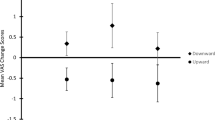Abstract
Despite the popular belief that the thinstandard of female attractiveness currently presented inthe media is a primary contributor to the high level ofconcern with body weight among women, experimental studies have not shown that exposure to mediaimages increases women's weight concern. Threeexperiments are reported demonstrating that exposure tomedia images does often result in increased weightconcern among women, but that body dissatisfaction, astable personality characteristic, is a moderator ofvulnerability to this effect. Although most womenreported higher weight concern when exposed to media vs. neutral images, women with low initial bodydissatisfaction did not. In addition, this researchsuggests that negative effects on weight concern mayresult from even passive exposure to media images, but that exposure to realistic attractivenessis less likely to cause increased weight concern. Theethnicity of the participants in these studies reflectedthat of the local population, with over 90% white. The nonwhite participants primarily belonged toone of the following groups; Asian, Pacific Islander,Latino.
Similar content being viewed by others
REFERENCES
Brown, J. D., Childers, K. W., & Waszak, C. S. (1990). Television and adolescent sexuality. Journal of Adolescent Health Care, 11, 62-70.
Buss, D. M. (1994). The evolution of desire: Strategies of hum an mating. New York: Basic Books.
Cash, T. F., Cash, D. W., & Butters, J. W. (1983). “Mirror, mirror on the wall...?” Contrast effects and self-evaluations of physical attractiveness. Personality and Social Psychology Bulletin, 9, 351-358.
Cash, T. F., & Henry, P, E. (1995). Women's body images: The results of a national survey in the U.S.A. Sex Roles, 33, 19-28.
Evans, N., Gilpin, E., Farkas, A. J., Shenassa, E., & Pierce, J. P. (1995). Adolescents' perceptions of their peers' health norms. American Journal of Public Health, 85, 1064-1069.
Feingold, A. (1990). Gender differences in the effects of physical attractiveness on romantic attraction: A comparison across five research paradigms. Journal of Personality and Social Psychology, 59, 981-993.
Franzoi, S. L., & Herzog, M. E. (1986). The body esteem scale: A convergent and discriminant validity study. Journal of Personality Assessment, 50, 24-31.
Franzoi, S. L., & Shields, S. A. (1984). The Body Esteem Scale: Multidimensional structure and sex differences in a college population. Journal of Personality Assessment, 48, 173-178.
Freedman, R. J. (1984). Reflections of beauty as it relates to health in adolescent females. Women and Health, 9, 29-45.
Garner, D. M. (1991). Eating disorder inventory-2. Odessa, FL: Psychological Assessment Resources, Inc.
Heinberg, L. J., & Thompson, J. K. (1992a). The effects of figure size feedback (positive vs. negative) and target comparison group (particularistic vs. universalistic) on body image disturbance. International Journal of Eating Disorders, 4, 441-448.
Heinberg, L. J., & Thompson, J. K. (1992b). Social comparison: Gender, target importance ratings, and relation to body image disturbance. Journal of Social Behavior and Personality, 2, 335-344.
Heinberg, L. J., & Thompson, J. K. (1995). Body image and televised images of thinness and attractiveness: A controlled laboratory investigation. Journal of Social and Clinical Psychology, 14, 325-338.
Irving, L. M. (1990). Mirror images: Effects of the standard of beauty on the self-and body-esteem of women exhibiting varying levels of bulimic symptoms. Journal of Social and Clinical Psychology, 9, 230-242.
Jacobi, L., & Cash, T. F. (1994). In pursuit of perfect appearance: Discrepancies among self-ideal percepts of multiple physical attributes. Journal of Applied Social Psychology, 24, 379-396.
Lakoff, R. T., & Scherr, R. L. (1984). Face value: The politics of beauty. Boston: MA: Routledge & Kegan Paul.
Markus, H. (1977). Self-schemata and processing information about the self. Journal of Personality and Social Psychology, 35, 63-78.
McCall, R. B. (1994). Fundamental statistics for the behavioral sciences (6th ed.). Fort Worth, TX: Harcourt Brace College Publishers.
Pagano, R. R. (1994). Understanding statistics in the behavioral sciences (4th ed.). New York: West Publishing Company.
Polivy, J., & Herman, P. C. (1985). Dieting and binging. American Psychologist, 40, 193-201.
Silverstein, B., Perdue, L., Peterson, B., & Kelly, E. (1986). The role of the mass media in promoting a thin standard of bodily attractiveness for women. Sex Roles, 14, 519-532.
Stein, D. M., & Reichert, P. (1990). Extreme dieting behaviors in early adolescence. Journal of Early Adolescence, 10, 108-121.
Stice, E., Schupak-Neuberg, E., Shaw, H. E., & Stein, R. I. (1994). Relation of media exposure to eating disorder symptomology: An examination of mediating mechanisms. Journal of Abnormal Psychology, 103, 836-840.
Striegel-Moore, R. H., Silberstein, L. R., & Rodin, J. (1986). Toward an understanding of risk factors for bulimia. American Psychologist, 41, 246-263.
Thomas, C. D., & Freeman, R. J. (1990). The body esteem scale: Construct validity of the female subscales. Journal of Personality Assessment, 54, 204-212.
Wear, R. W., & Pratz, O. (1987). Test-retest reliability for the Eating Disorder Inventory. International Journal of Eating Disorders, 9, 265-273.
Wolf, N. (1991). The beauty myth: How images of beauty are used against women. New York: Morrow.
Wood, J. (1989). Contemporary social comparison theory. Psychological Bulletin, 106, 231-248.
Wooley, O. W., & Wooley, E. (1984, Feb.) Feeling fat in a thin society. Glamour, pp. 198-252.
Rights and permissions
About this article
Cite this article
Posavac, H.D., Posavac, S.S. & Posavac, E.J. Exposure to Media Images of Female Attractiveness and Concern with Body Weight Among Young Women1. Sex Roles 38, 187–201 (1998). https://doi.org/10.1023/A:1018729015490
Issue Date:
DOI: https://doi.org/10.1023/A:1018729015490




